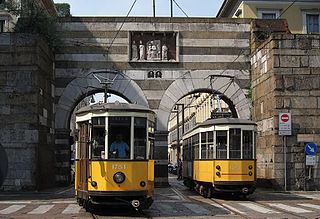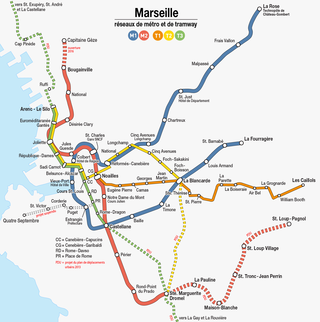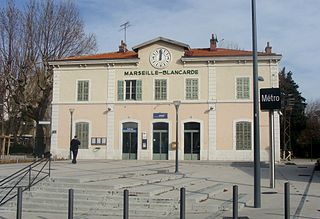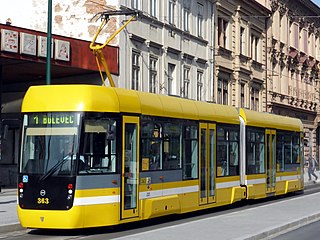
The Xochimilco Light Rail is a light rail line that serves the southern part of Mexico City. It connects to, but is not considered a part of the Mexico City Metro. Rather, it is operated by the Servicio de Transportes Eléctricos (STE), the authority that operates Mexico City's electric trolleybus system and formerly operated the municipal electric tram system.

The Brussels tramway network is a tram system serving a large part of the Brussels-Capital Region of Belgium. It is the 16th largest tram system in the world by route length, in 2017 providing 149.1 million journeys over routes 140.6 km (87.4 mi) in length. In 2018, it consisted of 18 tram lines. Brussels trams are operated by STIB/MIVB, the local public transport company.

Europe has an extensive number of tramway networks. Some of these networks have been upgraded to light rail standards, called Stadtbahn in Germany, premetros in Belgium, sneltram in the Netherlands, metro ligeiro in Portugal and fast trams in some other countries.

Germany has an extensive number of tramway networks. Some of these networks have been upgraded to light rail standards, called Stadtbahn in German. Straßenbahn and Stadtbahn schemes are usually operated on the legal foundation of the BOStrab, the Tramways Act of Germany.

Trams in Nice was the first-generation tramway system serving the city of Nice, France, which operated from 27 February 1879 to 10 January 1953.

The Nantes tramway is a tramway system operating in the city of Nantes in Pays de la Loire, France. The first tramway in Nantes opened in 1879 and closed in 1958 due to bombing damage during World War II, while the present tramway was re-introduced to the city in 1985.

The Tramway Français Standard (TFS) is a type of tram designed and manufactured by Alstom for use on various tramway systems in France. The TFS is no longer in production, having been superseded by the Alstom Citadis range of tramcars.

The Marseille Metro is a rapid transit system serving Marseille, France. The system comprises two lines, partly underground, serving 31 stations, with an overall route length of 22.7 kilometres (14.1 mi). Line 1 opened in 1977, followed by Line 2 in 1984. Two stations, Saint-Charles and Castellane, each provide interchange between lines.

The Saint-Étienne tramway is a tram system in the city of Saint-Étienne in the Rhône-Alpes (France) that has functioned continuously since its opening in 1881. The first tramway line was steam-operated and was opened by the Chemins de Fer à Voie étroite de Saint-Étienne (CFVE) on 4 December 1881, stretching for 5.5 km between La Terrasse and Bellevue. The CFVE took over the Compagnie des Tramways Électriques de Saint-Étienne lines and discontinued the use of steam in 1912.

Trams in France date from 1837 when a 15 km steam tram line connected Montrond-les-Bains and Montbrison in the Loire. With the development of electric trams at the end of the 19th century, networks proliferated in French cities over a period of 15 years. Although nearly all of the country's tram systems were replaced by bus services in the 1930s or shortly after the Second World War, France is now in the forefront of the revival of tramways and light rail systems around the globe. Only tram lines in Lille and Saint-Étienne have operated continuously since the 19th century; the Marseille tramway system ran continuously until 2004 and only closed then for 3 years for extensive refurbishment into a modern tram network. Since the opening of the Nantes tramway in 1985, more than twenty towns and cities across France have built new tram lines. As of 2024, there are 28 operational tram networks in France, with 3 more planned. France is also home to Alstom, a leading tram manufacturer.

The Rome tramway network composed of 6 tram lines operating in the city of Rome, Italy, part of the Rome’s public transport network. The current tram system in Rome, is a leftover from what once was the largest tram system in Italy. The system is owned and operated by Azienda Tranvie e Autobus del Comune di Roma.

The Antwerp tramway network is a network of tramways forming part of the public transport system in Antwerp, a city in the Flemish Region of Belgium. The network is operated by the Flemish region's transportation company De Lijn. As of April 2017, it featured fourteen lines, eight of which pass partially underground.

Trams in Vienna are a vital part of the public transport system in Vienna, capital city of Austria. In operation since 1865, with the completion of a 2 km (1.2 mi) route to industrial estates near Simmering, it reached its maximum extent of 292 km (181.4 mi) in 1942. In February 2015, it was the fifth largest tram network in the world, at about 176.9 kilometres (109.9 mi) in total length and 1,071 stations.

The Neuchâtel tramway is a tramway forming part of the public transport system in Neuchâtel, a city in Switzerland.

Public transport in Marseille is managed by the Régie des transports Métropolitains. In 2011, there were 159 million trips, averaging 600,000 trips each weekday.

Marseille-Blancarde station is a French railway station located in the city of Marseille, in the Bouches-du-Rhône department in the Provence-Alpes-Côte d'Azur region. It is also a station on Line 1 of the Marseille Metro.

The Aubagne tramway is a tram system in the commune of Aubagne, Aix-Marseille-Provence Metropolis, France. It consists of a single 2.8 km (1.7 mi) line called Line T, which serves seven stations since its inauguration on 1 September 2014 and does not charge fares.

The Plzeň tram network is a tram network serving Plzeň, the fourth most populous city in the Czech Republic.

Semi-metro is a form of urban rail transport in which trams run partly on a conflict-free track, by using tunnels and viaducts. These stretches of track are designed to function like a regular metro or rapid transit line. Semi-metro lines run with tram cars because they are usually developed from an existing tram network. Semi-metro is a concept also known as a subway–surface line/system, tram subway line/system, trolley subway system or a hybrid streetcar / light rail line)
























